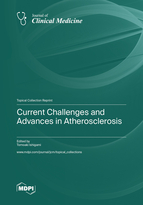Current Challenges and Advances in Atherosclerosis
A special issue of Journal of Clinical Medicine (ISSN 2077-0383). This special issue belongs to the section "Cardiovascular Medicine".
Deadline for manuscript submissions: closed (25 February 2024) | Viewed by 24759
Special Issue Editor
Interests: atherosclerosis; inflammation; antigen; antibodies; auto-antibodies; interleukin 5; B1 cell; B2 cell; spleen; tertiary lymphoid tissue
Special Issues, Collections and Topics in MDPI journals
Special Issue Information
Dear Colleagues,
Atherosclerosis is a phenomenon which is of major interest in both basic science and clinical medicine in order to achieve healthy longevity worldwide. Atherosclerosis generally develops without any signs and symptoms, eventually resulting in various kinds of catastrophic cardiovascular events, such as ischemic heart disease, ischemic stroke, and rupture of major vessel aneurysm. Scientists working on the biological aspects of atherosclerosis have recently focused on the inflammation seen in vessel walls from intimal to adventitial tissues. However, although inflammation is indeed a dominant pathological phenomenon in atherosclerosis, it has been recognized that there is no simple answer to the question of whether inflammation promotes or retards atherosclerosis. Atherosclerosis is a complex disease that involves several different cell types, such as lymphocytes, macrophages, monocytes, dendric cells, and their molecular products. Chronic inflammation in atherosclerosis might be accompanied with basical immunological changes, including auto-immune disorders. For example, recent studies have shown that multiple auto-antibodies are found in the sera of the subjects with atherosclerosis via inventory high-throughput auto-antibody screening techniques using cell-free technologies. Nevertheless, the immune system is even more complicated, with many cell types, hundreds of cytokines, and literally millions of different antigens. This Special Issue, titled “Current Challenges and Advances in Atherosclerosis”, will focus on recent challenges and advances in the field of atherosclerosis by global expert scientists and clinicians to elucidate the complicated features of atherosclerosis and translational attempts for medical–clinical frontiers.
All papers submitted to this Special Issue are reviewed by independent referees, and the final decision is made by a JCM Editorial Board Member who does not have any conflicts of interest with the submission.
Dr. Tomoaki Ishigami
Guest Editor
Manuscript Submission Information
Manuscripts should be submitted online at www.mdpi.com by registering and logging in to this website. Once you are registered, click here to go to the submission form. Manuscripts can be submitted until the deadline. All submissions that pass pre-check are peer-reviewed. Accepted papers will be published continuously in the journal (as soon as accepted) and will be listed together on the special issue website. Research articles, review articles as well as short communications are invited. For planned papers, a title and short abstract (about 100 words) can be sent to the Editorial Office for announcement on this website.
Submitted manuscripts should not have been published previously, nor be under consideration for publication elsewhere (except conference proceedings papers). All manuscripts are thoroughly refereed through a single-blind peer-review process. A guide for authors and other relevant information for submission of manuscripts is available on the Instructions for Authors page. Journal of Clinical Medicine is an international peer-reviewed open access semimonthly journal published by MDPI.
Please visit the Instructions for Authors page before submitting a manuscript. The Article Processing Charge (APC) for publication in this open access journal is 2600 CHF (Swiss Francs). Submitted papers should be well formatted and use good English. Authors may use MDPI's English editing service prior to publication or during author revisions.
Keywords
- atherosclerosis
- inflammation
- antigen
- antibodies
- auto-antibodies
- B cell
- T cell
- tertiary lymphoid tissue







